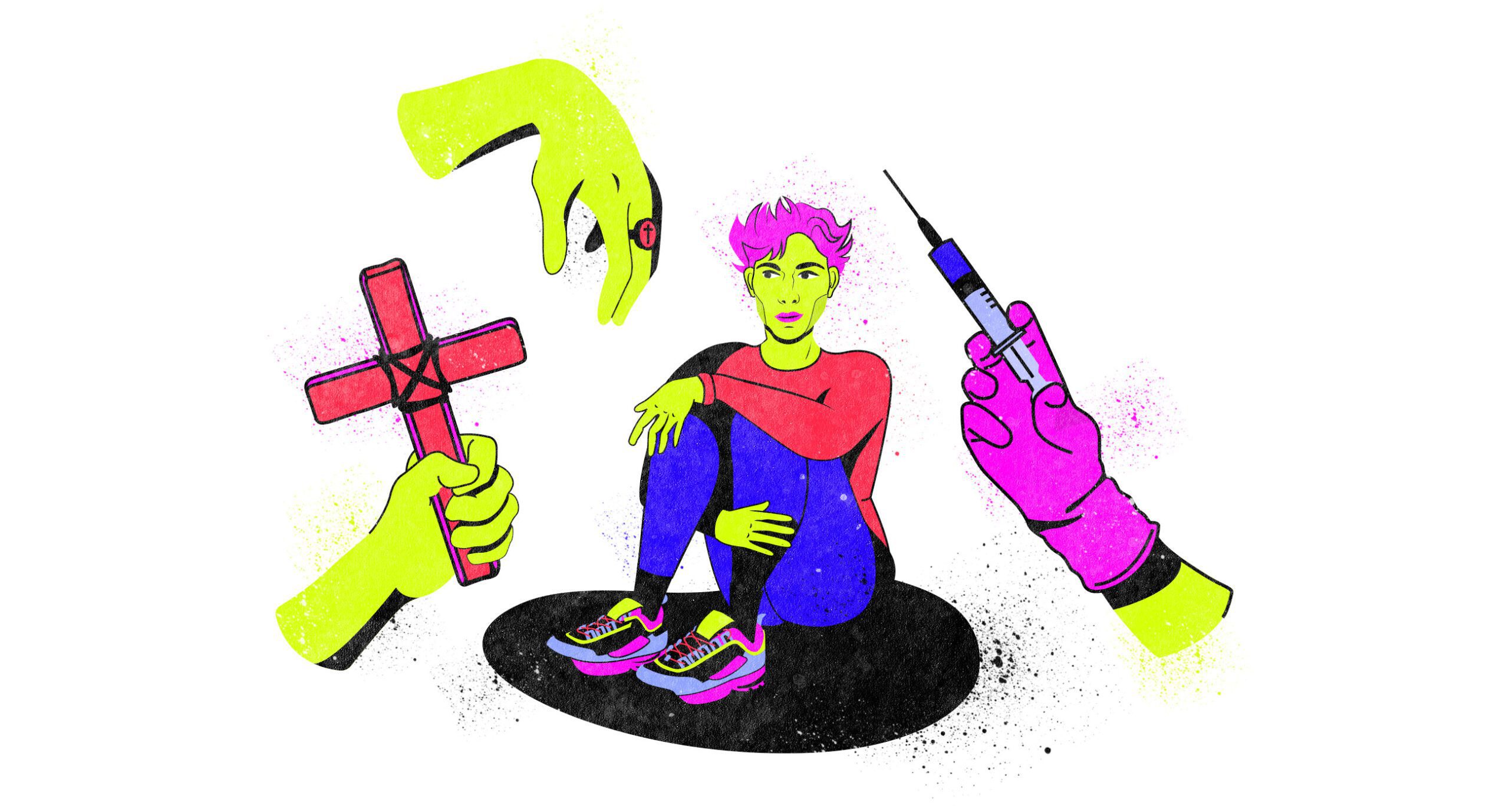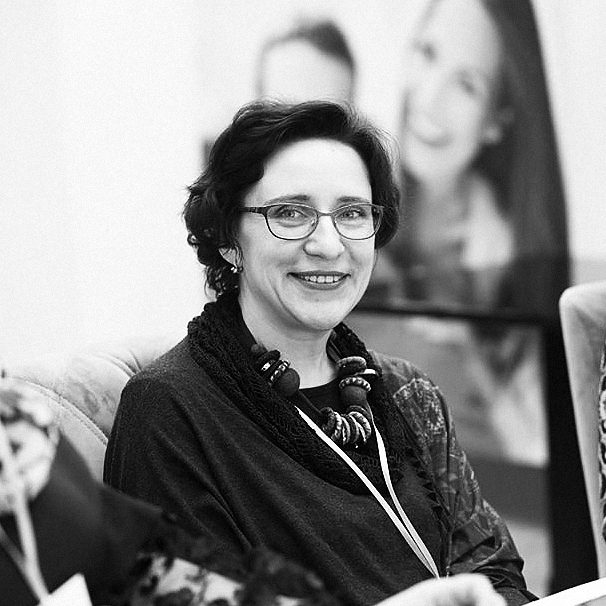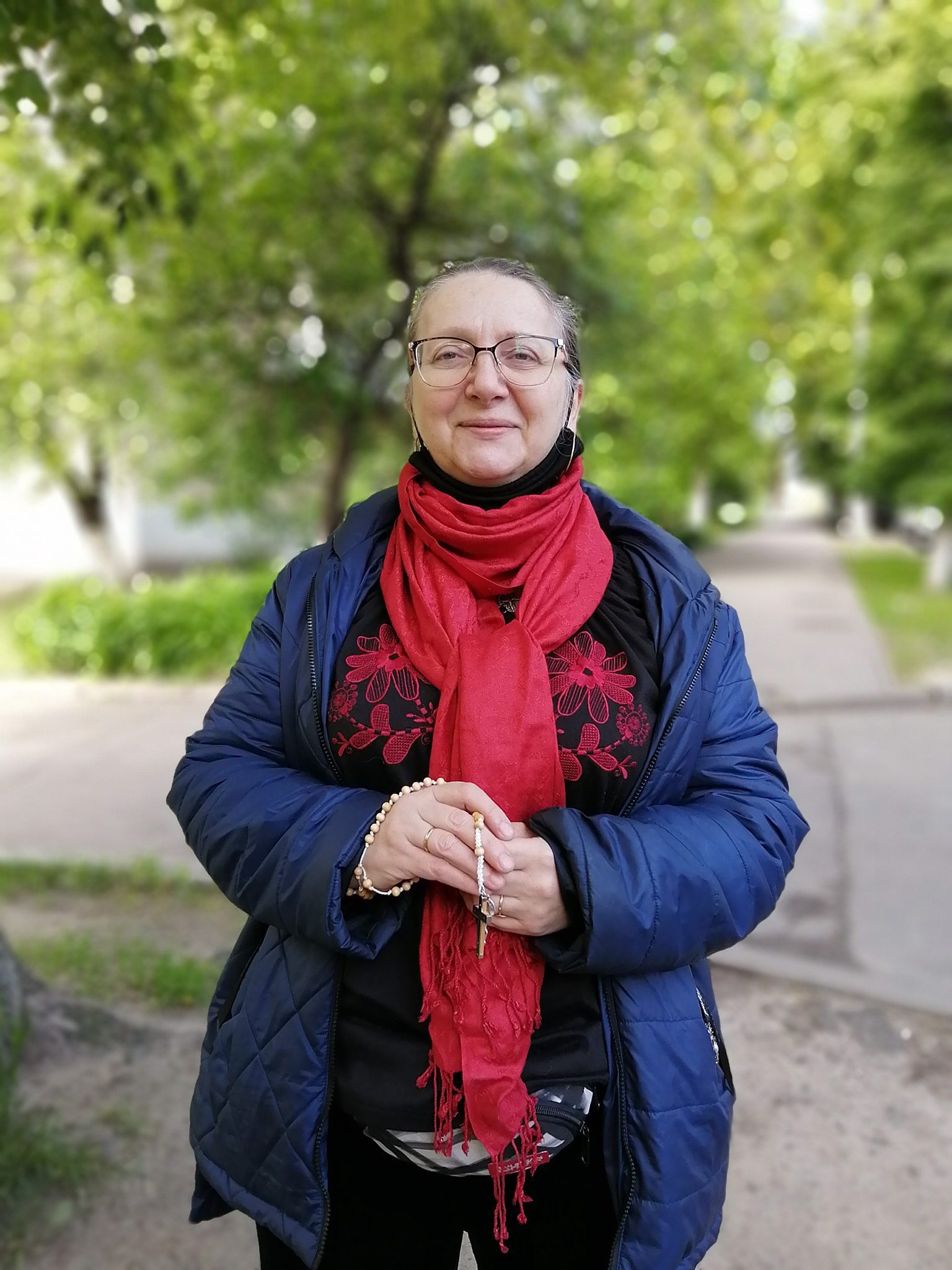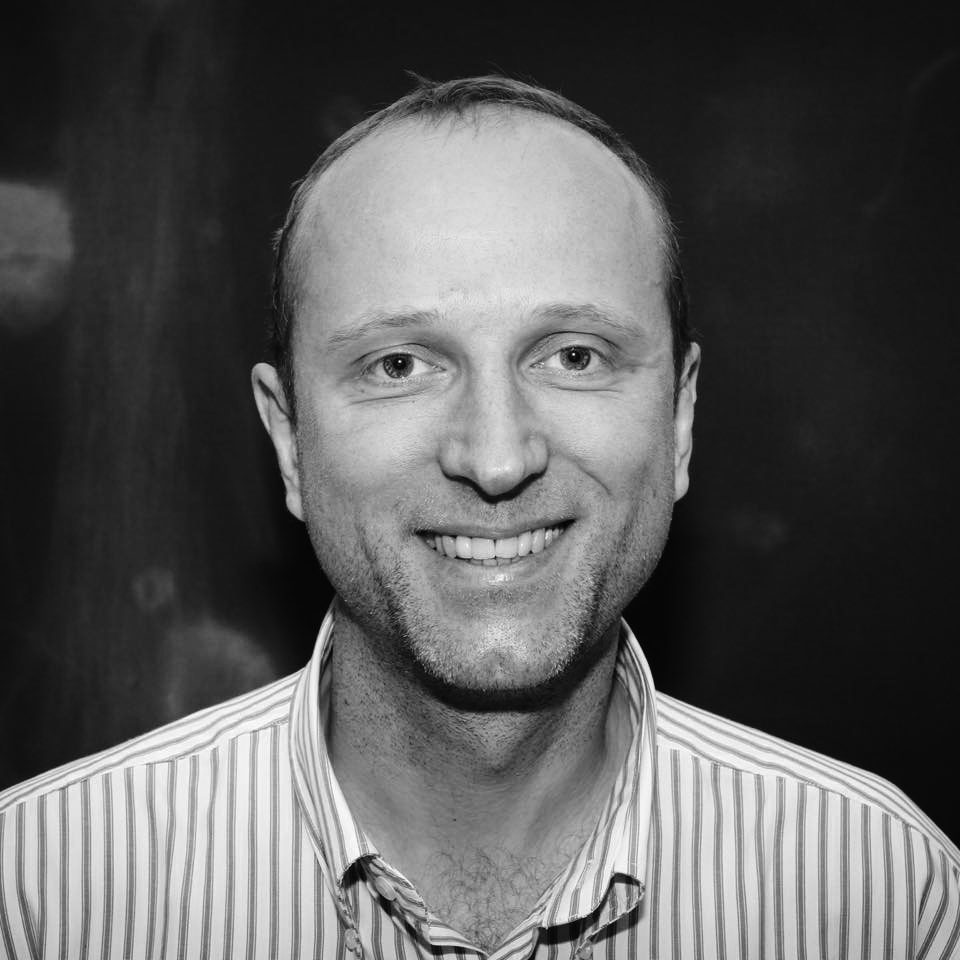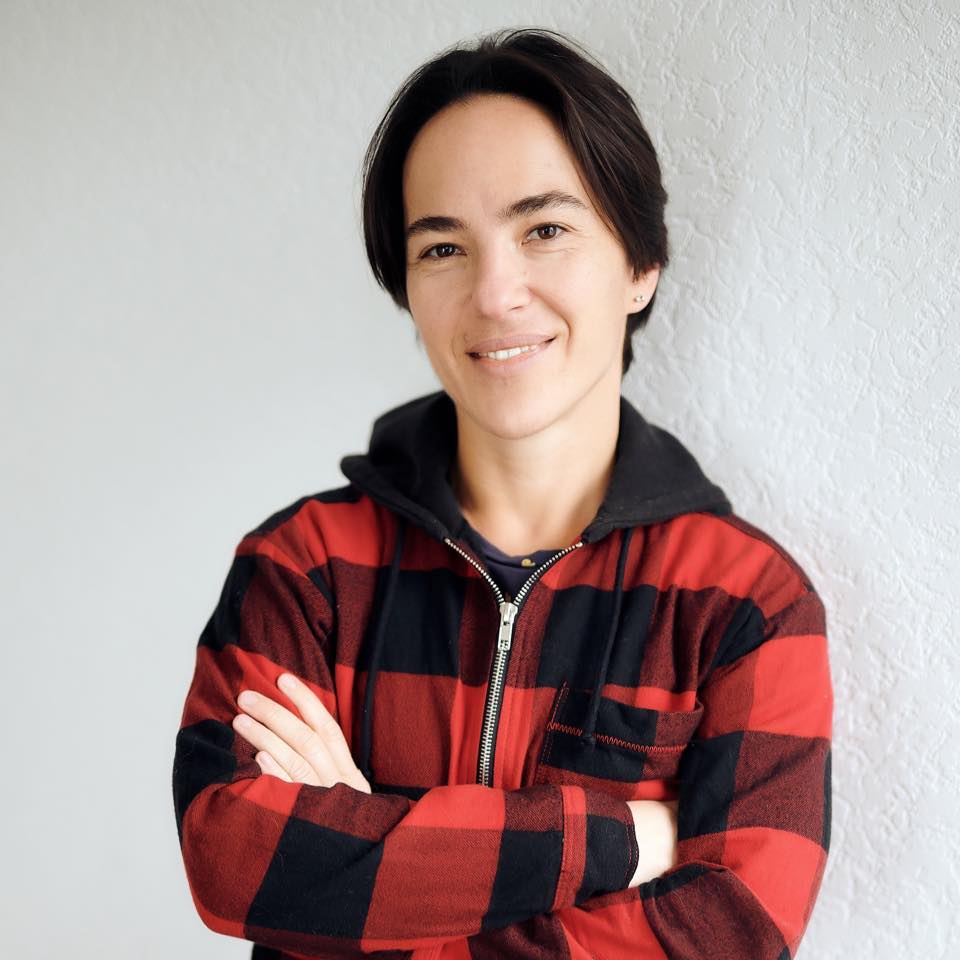Conversion therapy is a practice that stems from anti-intellectual premises, the idea that homosexuals, bisexuals, transgender or gender non-conforming invidiuals are morally, spiritually, or even physically ‘sick’ and incompetent, and they need to be ‘cured.’ This can take the form of individual or group consultations, as well as much more invasive ‘treatments’, such as sleep deprivation, antipsychotic prescriptions, electroshock therapy, and even ‘corrective’ rape. In recent years, Western countries have recognized that any ‘corrective’ measures taken against an individual’s gender identity or sexuality are fraudulent, and a form of torture. Yet in Ukraine, there is no lack of dubiously-credited ‘specialists’ and organizations that ‘help cure homosexuality.’
Zaborona journalist Samuel Proskuryakov went undercover in order to discover how the conversion therapy industry works in Ukraine.
Modern science dismisses conversion therapy as ineffective and even harmful. However, Ukraine’s medical universities and training facilities still teach by out-dated textbooks that name homosexuality as a pathology. Even so, no one can properly explain how this ‘pathology’ is to be treated, which is why all the so-called ‘healers’ provide whatever ‘treatment’ they personally see fit. Some limit themselves to conversations, some jump straight to extreme methods like electroshock therapy or ‘corrective’ rape. Pseudoscience lacks ethical standards.
Both accredited, medically trained professionals and amateurs provide conversion therapy services. The ‘treatments’ might be free, or paid, in both psychologist’s offices and in churches.
Research
In the summer of 2020, Freedom House, an international organization, held a survey on the origins and spread of conversion therapy in Ukraine. It turned out that similar practices were rather wide-spread in the country, and often used.
According to the survey, religious leaders (89%) and family members (75%) are the chief promoters of conversion therapy. The top ‘healers’, stated the survey respondents, were those same religious leaders (84%), ‘traditional doctors (57%), and private psychological and psychiatric clinics (45%).
The survey also showed that conversion therapy was most used against under-18 LGBT+ teenagers (67%), while the main forms of ‘treatment’ were identified as religious rites (59%), prayer (54%), and committment to a specialized facility (51%). Non-binary individuals further identified physical force as another form of ‘therapy’ (60%).

Illustration: Artem Markov and Alina Safonenko / Zaborona
Sofia’s Story
In 2018, Sofia (her last name has been changed for safety reasons) was 18 years old when her ‘therapy’ began – attempts to change her homosexual orientation to a heterosexual one.
Sofia’s parents had long held suspicions about their daughter – in college, Sofia had short hair, went to parties without talking about who was there, brought flowers home and when asked about them, meekly explained that they were gifted to her by her classmates. Her mother found out everything when she came across a Facebook post about a march to commemorate the Transgender Day of Remembrance: one of the photographs showed Sofia holding a sign reading “We have the right to be ourselves.”
“The next day, I get up and want to have some coffee, do my morning exercises – like normal,” Sofia told Zaborona, “And suddenly my mother barges in saying she knows everything. I began to go into hysterics, I’m sobbing, and she’s attacking me, snatching my phone, then held a knife up to her own throat and said that I did this to her. I tore the knife from her – it was insane.”
Her father shortly learned of it all as well. He was very upset, saying that Sofia had moved against her own family and against tradition. When Sofia would come home, no one would speak to her. Her parents would not acknowledge that their daughter liked girls. Her mother began to drink, and her father blamed her mother’s drinking on Sofia.
Sofia’s mother tried to discover who Sofia was dating, and then wrote to their pediatric family doctor. The pediatrician advised her mother to approach psychiatry with the words, “it’s a disease that must be treated.” Her mother went to a psychiatrist on that recommendation, but was turned down as the psychiatrist explained that they couldn’t legally treat Sofia – but they recommended a psychologist instead.
“When I went to a session, my mom remained outside the office,” recalls Sofia. “The psychologist just began badgering me. He said that people besides me had long lived before the birth of Christ in Sodom, and that I’m entering into a conflict with society and that’s why I will have psychosomatic diseases, cancers, and that I’ll die because I’m going against female nature.”

Illustration: Artem Markov and Alina Safonenko / Zaborona
The psychologist kept insisting that Sofia needed to go to regular sessions with him – that this would somehow help her find ‘harmony’ with her ‘female nature.’ He claimed that the reason for her attraction to women lay in trauma, and that no one is born gay or lesbian. This was a monologue, not a dialogue – the psychologist didn’t allow the girl to say a word.
Then the psychologist told her mother all the details of the session, violating patient-doctor confidentiality and violating professional ethical principles. The doctor’s diagnosis? Sofia had been ‘brainwashed’ to hate men, and could be helped only with some ‘fundamental’ treatments.
Sofia decided that was enough and flatly refused any sort of therapy. She tried spending less time at home – she would go to training sessions, stay late at college, and sleep over at her friend’s dorm room. In 2020, Sofia found a job and rented her own apartment. Her parents haven’t bothered her since then, and relations have gone back to normal.
A psychologist and her ‘Godly’ path
Judging by the responses to the Freedom House survey, conversion therapy is founded on the belief that homosexuality is a medical or psychological problem that can be ‘cured.’
Zaborona managed to find such a psychologist in the country, who considered homosexuality to be a disease that can and must be treated. This was the most well-known ‘specialist’ in this ‘field’ – Lyudmyla Hrydkovets. She holds a doctorate in psychological sciences, heads the Psychology and Pedagogy faculty at the Kyiv Institute of Business and Technology, and is the founder and chairman of the “Ukrainian Association Of Christian Psychologists.” According to her, homosexuality has its origin in birth traumas, and can be cured. It wasn’t easy to contact her. Lyudmyla is a very busy person: she travels around the country and consults other ‘specialists’ and holds lectures about the “dangers of gender politics.” Her ‘professionalism’ is held in high esteem by many – for example, by Lidiya Kondratik, a teacher at Ivana Franka Lviv University and at the Ukrainian Catholic University, and a practicing psychologist herself.
“Look: if you see a tendency towards homosexuality – then that’s definitely a question for Lyudmyla Hrydkovets,” Kondratik told me over the phone. “She’s had very very good results with her work. She’s just a specialist in this field and can immediately see the root of the problem: is it medical or something spiritual.”

Lidiya Kondratik
Lyudmyla, the so-called Christian psychologist, recommended meeting at the Church of St. Nicholas the Good, in Kyiv’s Podol neighborhood. She warned us that this would be a group consultation in the form of a “constellation”, a pseudo-scientific psychological technique, but didn’t provide any further details. On the way there, I repeated my cover story to myself – I’d chosen the name Sasha, I’m 25 years old, and I work as a waiter. I’m gay – and I want to cure myself.
This ‘constellation’ was held on the third floor of the church. Chairs were arranged in a circle facing inward. Ten participants had gathered for the ‘therapy’, including Lyudmyla.
The ‘constellation’ method was developed by German philosopher and theologian Bert Hellinger. He had neither a psychological nor a medical background. This is a strange mix of systemic family therapy and mysticism, to which Lyudmyla Hrydkovets added Christian faith teachings. In other words – pseudoscience.
The constellation is held in a group divided into the clients with some sort of psychological problem, while the rest of the members play the role of ‘figures’. There are many different types of ‘figures’: the client’s ‘representative’ (acting as a doppelganger), the ‘Godly Path’: one or multiple members of the client’s family, as well as abstract understandings like ‘soul’, ‘health’, ‘depression’, ‘syndrome.’
The client takes one of the ‘figures’ around the shoulders and arranges them around the room however they like. The only figure that remains independent of the client and chooses its own place is the ‘Godly Path’. The ‘Godly Path’ is also given a heavy painting of a saint to wear. Then the client moves to the side and watches what goes on with the figures.

Lyudmyla Hrydkovets / Facebook
A few minutes pass. The figures remain silent: they’re seemingly tuned in to receive information from some otherworldly source. At Lyudmyla’s command, some sort of psycho-drama mixed in with spiritism begins, or perhaps a version of a live-action role play: people move around, hold dialogues, and explain their own concerns and feelings.
The client, alongside Lyudmyla, analyzes the situation and asks questions. Some clients even begin speaking to the figures, as if they were their actual relatives.
One impressionable girl asks Lyudmyla for some clarifications on who she is and where she’s from. The ‘psychologist’ closes her eyes and begins to talk about ancient events as if she’d witnessed them.
Lyudmyla alleges that she saw how a small boy – the grandfather of the client – was running across a field and ran out of breath: communists were chasing him. The client begins to cry on hearing those words, but Lyudmyla continues to tell the story of Bolshevik atrocities in her grandfather’s home village: the boy was taken out to be shot three times, but just for intimidation’s sake – that’s why the client is scared of losing her boyfriend.
A similar scenario is played out for my benefit. During it, Lyudmyla tells me that my mother was also raped by some sort of drunken thugs – possibly, that’s why I’m ‘gay.’
After all that, Lyudmyla suggests singing religious songs, praying, and asks us to repeat several sentences after her – and then prescribes our ‘treatment.’
My ‘treatment’ from Hrydkovets looks like this: over the course of 40 days, I have to start each morning with a ritual. I have to stand with my back to the wall, take a deep breath, and “feel how my father, mother, their parents and my entire familial line stand behind me.” Then I have to picture the ‘Godly Path’ in front of me, and then audibly say and do the following:
“O God, thank you for my father!” Bow. “O God, thank you for my mother!” Bow. “O God, thank you for my father’s family!” Bow. “O God, thank you for my mother’s family!” Bow. “O God, thank you that I’m a son of this great family!”
After that, says Lyudmyla, “with all that in mind” I have to take a step “into the new day.” If I miss even a single day, the counter resets and I’ll have to start everything over.
Hrydkovets alleges that after a ‘treatment’ of this kid, I’ll no longer need her help. But if the ‘treatment’ isn’t enough, she’ll be waiting to hold individual sessions with me after the forty day period.
Psychiatry and its specifics
I also attempted to visit a psychiatrist or at least a psychotherapist – the former could prescribe antidepressants and medical treatments.
A few clinics immediately explained that homosexuality is normal and no treatment is necessary. However, I was looking for the few that said that could help me “get rid of my problem.” Two specialists in Kharkiv agreed to talk further on this topic: a cognitive behavioral psychotherapist and a narcologist-psychiatrist.
The first prescribed several medicines – but not from homosexuality (as those don’t exist), but for anxiety, in order to help me “calmly accept myself.” The psychotherapist explained that the human population always has a few percent of the population with non-heterosexual leanings, and that it isn’t a pathology.
“You need to drink the medicine. Your anxiety will go away, and you’ll be able to calmly look at everything and go to a psychologist who’ll take care of you,” said the psychotherapist. “This is a purely personal matter. How you want to have sex, with whom, when, and everything else. The weight of the matter is whether or not the person themselves are okay with that. You can’t say that same-sex relationships are bad.”
The narcologist-psychiatrist advised talking to some men registered in a gay dating app, to meet with them and maybe go on a date.
“Love whomever you want to love,” she told me. “Yes, society looks at this oddly. But, firstly, you don’t need to put up a listing on OLX (a local shopping site comparable to Ebay – ed.), saying ‘I love boys.’ Secondly, it’s not ok to go against your own nature. You don’t buy groceries you have a food allergy to after all, to put it bluntly. And if you try to break yourself right now, then you’re risking very serious psychological disorders.”
However, this sort of advice isn’t always the case.
The methods of the Church
Aside from some psychologists, LGBT+ individuals are also ‘treated’ and ‘diagnosed’ by religious figures, who consider sexual attraction to the same gender a grave sin. Zaborona journalist Svetlana Oslavskaya recently attended an ‘exorcism theater’ an hour’s ride from Kyiv.
The Freedom House survey establishes that religious motives play a leading role in the belief that homosexuality needs to be ‘treated’. The biggest promoters of conversion therapy are cited to be religious leaders, and the top ‘healers’ are called faithful.
Getting rid of demons and devils is a whole industry. Many religious centers make exorcism a part of their image – for example, the Pochayiv Lavra in Ternopil Region in Ukraine. Priests, in addition to healers, fortune-tellers, midwives, and psychics, often engage in expelling ‘demons.’
Edward Riz is from Dnipro city. They’re a non-binary person who identifies as queer. People like Edward reject the gender binary – the stereotypical ‘masculine’ or ‘feminine’ behaviors.

Edward Riz. Photo: Ivan Chernichkin / Zaborona
“I don’t feel like a woman or a man, in fact, always,” Riz tells us. “Other children said: ‘I’m a boy’ or ‘I’m a girl.’ I always said that I’m an elf or something like that. That is, from my children I understand that all of these feminine things weren’t for me. They’re somewhere out there, while I’m here.”
Edward met their first male-identifying partner at university. But to Riz’s parents, Edward introduced them as their friend. However, at some point their parents realized that the person wasn’t just a friend, and began pressing Edward for answers in the kitchen.
“I replied ‘Well ok, it’s true: we’re dating.’ My parents just went crazy – my mom turned into some sort of harpy. They began screaming at me, saying that that’s it for me, that they’ll lock me at home and never let me out, that it’s a sin – my mom at that time was very Orthodox [Christian]”, Riz recalls.
Riz’s parents physically assaulted them, took their phone away from them and kept them locked up for several days at home. Then they engaged the services of an exorcist. Truthfully, the exorcist was probably not a priest, but some sort of medicine man, Riz remembers, and the exorcism itself was held not in a church, but in the apartment. Edward was lying on the divan while the exorcist, over the course of an hour, read prayers, waved a censer over him, and sprayed him with holy water.

Edward Riz. Photo: Ivan Chernichkin / Zaborona
When their parents understood that the exorcism had failed to work, they decided to send them on a pilgrimage of Kyiv’s churches. They visited all the churches of the capital city in a single day, left candles and read prayers while sitting on their knees in front of altars. They never gave Edward’s phone back and forbid them from talking to their friends.
They returned to Dnipro after this, and after some time, left Edward with their relatives in the suburbs. Edward managed to run away and join their partner in a rented apartment. Life seemed to come together: Piz found work and lived with their loved one. But Riz’s parents didn’t leave them alone: they hunted down addresses, visited Riz’s working office, fought with Riz’s management, and looked for Edward at the university.
“They visited the university and told stories that we were lesbians, witches, and that we worshipped the devil,” Riz recalled. “They tried to set all of my classmates against me, saying that I’d gone insane and was schizophrenic, that I’d run away from home and wasn’t accepting treatment. For the first three years I was constantly paranoid that they’d find me – they’d even call taxi agencies in order to find out where I’d been taken, and threatened to have me institutionalized.”
After a few years, Riz’s parents gave up.
Pochayiv Lavra
The Pochayiv Lavra in Ternopil Region is known for holding exorcisms, or, as it’s called here, ‘admonition.’ This is a prayer that supposedly frees a person from ‘devils’ and ‘demons.’ Over the phone, the porter (here something similar to an operator or a secretary) explained that an evil spirit lives inside me: ‘Sodomy.’ I’ll need to travel to the lavra and confess to the priests – then the demon will let me go.
As soon as I arrived at the lavra, the guard recommended that I remove my mask: “This is a holy place, it kills all viruses!” I was later given a brochure where one of the sins was listed as “a fear of suffering, an impatience of sorrow and disease – these are released by God to cleanse the soul from sin.”
The most important church of the lavra, the Holy Cathedral of the Assumption of the Virgin, was packed with people, to the point of overcrowding. There were over 500 visitors, and everyone was maskless.
Before you can start confession, you first need to write down a list of sins you want to repent for. After closely studying the list of sins pinned on a wall, I understand that it would be easier to write what I hadn’t committed. In that list, homosexuality was noted as ‘sodomy.’

Photo: Samuel Proskuryakov / Zaborona
I get in line for confession. I roll my cover around in my head, trying to express shame. When my turn comes, my head is wrapped with an epitrachelion – this is a kind of a long stole which is wrapped around a priest’s neck, with both ends hanging down onto the priest’s chest.
The priest explains that all of this “sodomitic disease’ came from the West, and I could have ‘caught’ it by listening to rock music, reading bad books, playing video games, and watching ‘amoral’ films (as I later learned from the brochures, special attention here was paid to the Harry Potter films.) The priest said that if I didn’t ‘stick’ to the church and didn’t become a member, then the ‘demon of sodomy’ would eat me alive.
The priest further explained that the Americans had closed an orphanage near Rivne, and now the orphans had nowhere to live and nothing to eat. If I wanted to be rid of my sins, I’d need to donate my money to charity. To buy food, diapers, bedding.
He reads off his personal phone number and asks me to call him in hte morning, in order for him to provide me with more detailed instructions: where to take my donations to in Kyiv, where to find a trustworthy priest. Then the priest orders me to kiss the icon, but seeing as I’m not visible under the stole, I refrain from doing so. Afterwards, he strongly presses my head against the shrine, and it seems to me for a moment the pressure of my forehead against the glass is going to crack it. The priest then forces me to repeat all of the sins I’d written down on the list after him, and sticks out his hand for me to kiss. There was no way out of that.

Illustration: Artem Markov and Alina Safonenko / Zaborona
The Protestant Method
Protestant churches also frequently see homosexuality as a disease and attempt to treat it. The ‘trick’ used by Protestant Charismatics is speaking in tongues – inarticulate sounds made while praying and considered to be a manifestation of the Holy Spirit. Charismatics also love emotional sermons, as well as upbeat music played with electric guitars, basses, drums, and synths. It’s likely that most readers are aware of this tendency: these are what the leader of the “Renaissance,” Volodymyr Muntyan, and the apostle Sunday Adelaja from the “Embassy of God” do.
At Charismatic meetings, people dance, laugh, cry, scream, hug, and roll on the floor. The preachers often give motivational speeches, most commonly on the topic of wealth and prosperity, as well as ‘healing’ from disease and expelling demons.
Additionally, attendees provide a tithe – a minimum of 10% of their salaries or business revenues. According to data provided by the Ministry of Finance, the average salary in Kyiv is currently around 18,504 UAH per month (approx. $675 – ed.) At the Kyiv affiliate of the international Charismatic movement “New Generation”, we counter around three hundred people at the Saturday service, with no less than 200 of them able to give tithes. This translates to, at the most conservative estimate, 370,000 UAH per month (approx. $13,500 – ed.).
In Kyiv, the “New Generation” bishop in Ukraine, Andriy Tyshchenko, recommended I find a good wife for myself. The preachers prayed for me and sent me to a secretary in order to find a mentor for me, and sign me up for a ‘home group.’
After talking to the secretary, I was approached by the pastor Vadym Kryvenko. He offered to hold an individual meeting with me at his office on the Maidan. There, the preacher explained that both venereal diseases, and spiritual ones, are passed through via “promicious sex.”
Another reason offered by Kryvenko for my supposed ‘hatred of women’ was a poor relationship with my mother and bad luck with girls.
“Your relationships with women weren’t built normally. It didn’t work once, it didn’t work twice, it didn’t work three times – and it switches, you know how it is, to men, because it’s easier here,” suggested the pastor.
He gave about “ten percent” to the idea that possibly I just watched too much pornography, and that’s why I’ve been pulled into a new impression.
The first thing I’d need to do for effective ‘treatment’, according to the pastor, was to regularly attend the Saturday sessions, and attend a ‘home group’ on Thursdays. I’ll also need to read the bishop, Andriy Tyshchenko’s book, “Saving Your Soul”, and as soon as I’m finished, come for a second meeting with Vadim. I’d also need to pray daily for no less than an hour.
At the end of the meeting, Vadim put his hand on my head and asked me to repeat a prayer after him. For a month I attended those Saturday services, once went to a home group, and then blocked all the phone numbers and never returned.
What the scientists say
Child and adolescent psychiatrist Dennis Ougrin has lived in the UK for over twenty years, and works at King’s College London. He’s a dean and a lecturer in the master’s course in Child Psychiatry there, one of the most prestigious universities in England.
He explained that modern science considers homosexuality to be a variety of the norm, just like hetero- or bi-sexuality. Today we know that, for example, anywhere from 8 to 25% of homosexual behavior is determined by genetic factors. We are also aware that heterosexual and homosexual males have differences in brain structure, and that having an older brother can increase the probability of being gay by up to 38%. Historical and anthropological studies show that homosexuality can be observed in every epoch of human existance, and has been treated differently depending on culture. We can also see examples of homosexuality in the animal kingdom.

Dennis Ougrin
The idea that homosexuality is a normal behavior is reflected in the positions of major international organizations such as the World Health Organization (WHO) and the American Psychiatric Association (APA).
Both of these institutions develop and publish practical guidance for doctors and psychiatrists around the entire world. These guidances cover the gamut of symptoms for all known mental disorders. WHO calls their version the “International Classification of Diseases” (ICD) and the APA – the “Diagnostic and Statistical Manual of Mental Disorders” (DSM). The authors of these documents are leading specialists in medicine and psychiatry. Homosexuality was removed as a disease from the DSM in the 1980s, while the ICD removed their definition in the 1990s.
However, conversion therapy advocates believe that these changes didn’t occure because of a deeper understanding of the nature of sexuality – but because of some sort of politicla conspiracy and pressure from the ‘gay lobby’.
“A huge amount of work is needed in order to include or exclude some diagnosis from the DSM,” explains Ougrin. “For example, we’ve already been working for many years to include a classification for nonsuicidal self-injury, or NSSI. My colleague from Columbia University, David Shaffer, has been working since DSM-4 [published in 1980 – ed.] to add it to the list. He was declined then, because there wasn’t enough of a research foundation. Then he tried to add changes to the DSM-4 [1994 – ed.] – also unsuccessfully. Finally, the DSM-5 was published [2013 – ed.], and NSSI was once again not added. Meanwhile, Shaffer was on pension. This is a very complicated work, and it is impossible to influence with some sort of ‘lobbying.’ Similar allegations, it seems to me, are a bit absurd.”
While discussing the effects of conversion therapy, Ougrin notes that even simple conversations can result in serious harm to one’s psyche. Children or adolescents who have gone through this ‘treatment’ develop internal conflicts between a false assertion that their orientation is unnatural, and the biological fact that it is impossible to change one’s orientation. In other words, victims of this ‘therapy’ try to fight with their unalterable inherent normalcy, as if blue-eyed people were suddenly accused of being sick or possessed by demons.
“Conversion therapy negatively impacts a child’s self-esteem and brings forth a feeling of guilt that leads to depression, with everything that implies,” says Ougrin.

Illustration: Artem Markov and Alina Safonenko / Zaborona
Why do we still have this problem in Ukraine?
The head of NGO Insight, Elena Shevchenko, explains that on the level of state-run clinics and hospitals, conversion therapy isn’t practiced. But there’s another problem: out-dated textbooks in universities and other centers of medical education.
For example, this is the content plan for a teacher at the Institute of Sociology, Psychology, and Social Communication at the Drahomanov National Pedagogical University in Kyiv. The majority of recommended text-books for students were written in the previous century, where homosexuality was, at best, considered to be sexual deviance.

Olena Shevchenko
Teachers are often homophobic as well. They’re members of disseratation committees, they influence the university’s atmosphere, and join together in every type of homophobic association – often inviting specialists who have nothing in common with medicine or psychology.
Shevchenko also notes that extreme types of conversion therapy, things like electroshock or gay porn demonstrations conducted simultaneously with naseau-inducing drugs in order to create a “condition digust reflex” do occur, though rarely.
But even ‘therapy’ by conversation can be dangerous: people may trust the ‘healer’ that cultivates a sense of guilt and an appearance of abnormality in the victim.
Going by the Freedom House survey, conversion therapy is most often applied to minors – 65% of respondents, 76% of those reporting that they were forced to do so. This says that the leading reason for the existence of conversion therapy in Ukraine is that a large number of parents deny their children’s homosexuality as something normal. As a result, they’ll continue looking for ways to solve this supposed ‘problem.’
The material was created with the support of international human rights organization Freedom House in Ukraine

